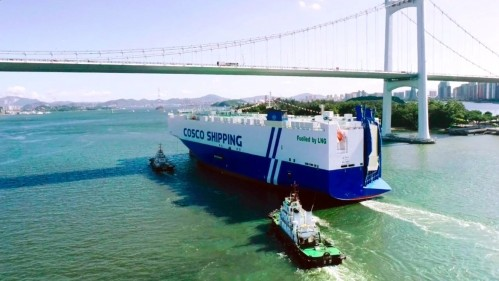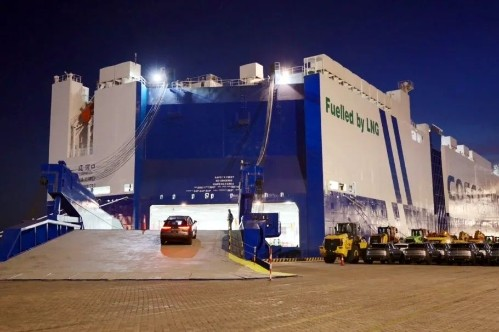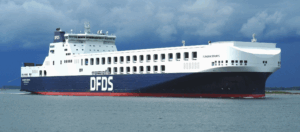
COSCO Shipping’s 7,500 CEU LNG dual-fuel roro ship was named for its maiden voyage on July 10. The newly launched vessel “Liao He Kou” from COSCO Shipping Specialized Carriers, a subsidiary of COSCO Shipping, is set to embark on its journey carrying over 5,000 commercial vehicles.
Its sister ship “Min Jiang Kou” will also transport more than 4,800 commercial vehicles following the completion of loading operations in Shanghai.
COSCO said that the vessels have been designed to meet the stringent International Maritime Organization’s TIER III emission standards, and will significantly “conserve energy and reduce emissions during operation.”
“Compared to traditional fuel oil vehicles and ships, they can save approximately 20% on energy consumption, cut about 27% of carbon emissions, 30% of nitrogen oxide emissions, 99% of sulfide emissions, and over 90% of PM particulate matter emissions,” the company claimed.
“Taking a typical round-trip voyage from China to Europe as an example, using LNG as an alternative fuel can reduce CO2 emissions by more than 2,100 tons per voyage,” it added.
The propulsion system of these ships is designed with a single engine and propeller configuration, employing an LNG dual-fuel main engine, a single-bow thruster, and an electric RoRo system.
With 13 vehicle decks and 7,500 standard parking spots, including four rise-and-fall decks, these vessels can accommodate a variety of vehicles such as passenger cars, trucks, and engineering machinery vehicles.
COSCO also claims that the new vessels “feature CCTV monitoring systems that offer complete coverage of the cargo hold areas, allowing for real-time end-to-end vehicle status monitoring.”
Looking ahead, the company and its joint venture, Guangzhou Yuanhai Automobile Shipping have ordered, since the beginning of 2022, 24 large-scale LNG dual-fuel RoRo ships, with capacities ranging from 7,000 to 8,600 parking spaces.
According to the delivery plan, the second half of this year will see the phased delivery and operation of 5 new ships.
Next year, 11 more ships are expected to be delivered, followed by an additional 6 ships by 2026. This expansion is expected to lead to a fleet of approximately 30 ships by 2026.



